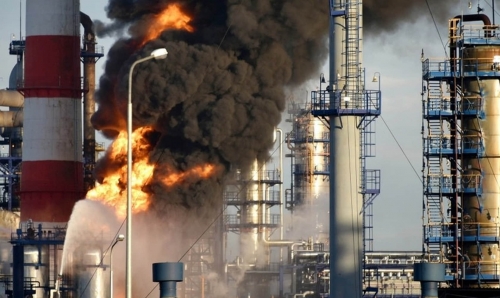Oil prices ended slightly lower after a week of minor ups and downs, with the markets focused on US tariffs on the EU and OPEC+ potentially reinstating more production.
BKR Rig Count | The total active drilling rigs in the United States decreased by 3 last week, to 563. Oil rigs dropped by 4 to 461, and gas rigs increased by 1 to 99. Rig count in the Permian Basin dropped by 1 to 278 | May 30 | BKR NAM Rig Count
US Crude Inventories, excluding those in the Strategic Petroleum Reserve (SPR), decreased by 2.8 MMbbl to 440.4 MMbbl (about 6% below the 5y average for this time of year). On the products side, gasoline decreased by 2.4 MMbbl (3% below the 5y average). Distillate fuels decreased by 0.7 MMbbl (17% below the 5y average). Total commercial petroleum inventories decreased by 0.7 MMbbl | May 23 | EIA Weekly Report
OPEC+ agreed to increase oil output for the third month in a row, adding 411k bpd in July, despite reservations from key member Russia, doubling down on a historic policy shift that has sent crude prices sinking. The hike matches increases scheduled for May and June. Several members expressed reservations about the speed with which OPEC+ was raising production. Russia, Algeria and Oman wanted a pause in the increases, delegates said | May 31 | Bloomberg
Kazakhstan said it can’t cut oil production and even hopes to increase output beyond planned levels later this year, deepening a stand-off with OPEC+ before the group meets this weekend. The possibility of Kazakhstan quitting the alliance — as some other members have done in recent years — remains a “tricky question,” but not the most likely outcome, according to Energy Aspects Ltd.“ Ultimately there will have to be a solution to this compliance problem,” which could come under the guise of maintenance at oil fields in the months ahead | May 29 | Bloomberg
In practice, as much as a third of OPEC’s advertised hike may not materialize and the amount that ultimately reaches the global market could be even less. OPEC [agreed] on Saturday to lift add backs to 1.37mbpd from July. Seven of eight nations have pledged to compensate for past cheating, cutting the increase to 1.1 million a day. If both Iraq and Kazakhstan keep production flat at the average March-April level, the expected 1.37mdpd increase becomes 972k bpd, 71% of the headline figure. Not all the additional barrels will reach global markets, Saudi could consume 80% of its production boost, for increased summer demand (power gen and water desalination) | May 29 | Bloomberg
Libya’s eastern government said it may shut down oil production and exports in protest after a militia aligned with rival authorities in the west stormed the state-oil company’s headquarters. The country is currently pumping just under 1.3 million barrels a day, most of the production exported | May 29 | Bloomberg
China’s imports of liquefied natural gas are on pace to fall 30% from a year ago in May, as the nation turns to cheaper alternatives. Deliveries in May are projected at about 4.6 million tons, according to Kpler, an analytics firm that tracks ship data. That would be the seventh month of year-on-year declines. BloombergNEF forecasts an 11% drop from last year to 68 million tons, although it raised the estimate slightly because of the pause in the tariff war with the US | May 26 | Bloomberg
Looking ahead
S&P Oil Markets Short-Term Outlook – June 2025 | Global liquids demand is projected to grow by 0.77 million b/d in 2025, and by 0.74 million b/d in 2026, slightly up since last month partly due to the tentative trade agreement between US and China. Nearly all of the net growth in oil (liquids) demand for the balance of this year is for petrochemical feedstocks with demand largely met by NGLs, not crude oil. In 2026, oil demand contraction is expected for the US, Canada, Europe, Japan and CIS, where growth is dominated by LPG and ethane. Global liquids supply forecast for 2025 is up by 485,000 b/d since last month, adjusted entirely for OPEC+ crude (up 602,200 b/d), only slightly offset by non-OPEC+ crude (down 94,000 b/d). A key assumption is that OPEC+ continues holding record spare capacity back to prevent excessive market loosening. In S&P’s view, increases are more likely to continue than to pause or cut. On its current path, OPEC+ (the “V-8”) will produce at fourth-quarter 2026 targets by October. If OPEC+ adds back this oil to the market, it will represent an extra 2 million b/d versus Q1 2025 levels. This includes structural increases in Kazakhstan and 200,000 b/d extra from Russia, but the most important chunk of the increase is all from the Gulf 3 (Kuwait, UAE and Saudi Arabia), which would add back 1.4 million b/d versus January levels. The incremental volume compounds in 2026, boosting global liquids supply by 1.1 million b/d versus last month. OPEC+ crude output is forecast to be 1.5 million b/d higher in 2026 than a month ago, while non-OPEC+ crude is down 359,000 b/d. S&P assumes this extra oil begins to pressure marginal barrels late 2025, but non-OPEC+ output will grow as price-resilient streams from Canada, Guyana and Brazil offset declining US output. S&P’s base case projects Dated Brent prices to fall from the $60/b range in Q2 to $49/b by year-end. The H2-25 average prices for Dated Brent and WTI are $55/b and $51/b, respectively. The 2026 price for Dated Brent is $56/b and for WTI, but with a rising trend during the year. S&P’s assumes OPEC+ completes its accelerated unwinding by the time of loading October exports. Combined with higher supply outside of OPEC+, year-on-year global crude oil (and condensate) production growth for second-half 2025 will be 2.2 million b/d compared with 390,000 b/d for crude oil demand growth. If this happens prices will fall, and market structure could flip to contango to incentivize stock building. Based on S&P’s crude-on-crude balance, pressure for stock building will be most pronounced in Q4 2025 and push commercial crude oil stocks well above year-earlier levels. If OPEC+ pauses the unwinding, there would still be a surplus, but of a lesser magnitude with a lesser impact on price since global crude oil inventories are currently low | May 29 | S&P
Rystad Oil Macro Monthly Report – May 2025 | Rystad forecasts global demand growth for liquids to be 700,000 bpd in 2025, and 830,000 bpd in 2026. The tariff outlook remains uncertain, with potential to weigh further on demand if new measures are introduced — or provide upside if negotiations lead to meaningful progress. Rystad has revised up their 2025 global liquids supply growth forecast, driven by an increase in production of crude oil and NGLs in the US. US supply is set to rise by 445,000 bpd, led by the Permian and Gulf of Mexico, though growth may slow in 2026 due to weaker investment. Rystad sees OPEC+ output increasing in 2H25 as voluntary cuts unwind. Already, May production could be up by 213,000 bpd. Non-OPEC+ supply (excluding the US) is forecast to grow by 940,000 bpd across 2025, led by Brazil, Argentina, Norway, and Canada. Most new supply is light and medium crude. Rystad has decreased their Brent price forecast for 2Q25 to an average of $66 per barrel from $68 in April, and projected to average $71 in 3Q25, supported by strong summer demand. Tight crude and liquids balances are expected to persist through the next four months before loosening in 4Q25 as refinery runs fall during maintenance periods. Backwardation has remained healthy at $1 per barrel. Much of the balance hinges on refinery run growth to supply products, as global product stocks are low across multiple complexes. Geopolitical risks remain heightened, with potential Middle East escalation and uncertainty in US-Iran nuclear talks adding further market volatility | May 28 | Rystad
OPEC+ looks set to push more oil onto a fragile global market for the third month in a row — but the motive behind the group’s strategy is no less elusive. Officials have offered a shifting range of explanations. Initially, they claimed to be satisfying “healthy” demand — a rationale at odds with Brent’s swift but brief collapse below $60 a barrel. Delegates subsequently said the Saudis had chosen to punish members such as Kazakhstan and Iraq for persistent over-production. Other officials suspect the supply surge is a concession to US President Donald Trump, who has urged OPEC to lower fuel costs and visited its Middle East leaders this month to widespread fanfare. More recently, they’ve pointed to another possibility: that the Saudis seek to reclaim the market share they’ve sacrificed to American shale drillers and other rivals during years of cutbacks. This would imply a seismic break with the strategy of market management that Riyadh has embraced for the past decade — and perhaps even the twilight of OPEC+ itself. The last time the kingdom picked a fight with shale, back in 2014, it threw in the towel after 18 months. It could also mean enduring prices near $65 a barrel or lower — far below the levels the Saudis need — for the foreseeable future. Whether Riyadh has the stomach for another battle like that remains to be seen | May 29 | Bloomberg

%20(1).png)



